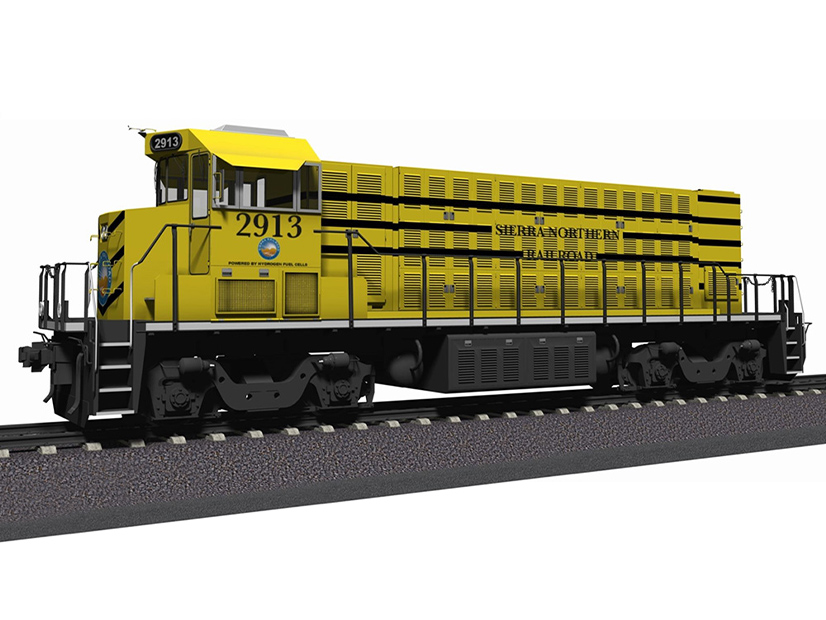
The California Air Resources Board approved a groundbreaking regulation Thursday to replace the worst-polluting diesel locomotives with cleaner engines by 2030 and to transition to 100% zero-emission (ZE) locomotives over the next three decades.
Diesel-powered locomotives run through many California cities, emitting greenhouse gases, nitrogen oxides (NOx) and fine particulate matter. Their emissions are expected to eclipse big-rig pollution as CARB’s clean-truck regulations take effect. (See Groundbreaking California Clean Truck Rules Win EPA Waiver.)
“It is imperative that locomotives moving freight as well as people transition to zero-emission, especially as additional new railyards are being built in the state and passenger rail services are expected to expand,” CARB Chair Liane Randolph said at Thursday’s board meeting.
“Communities near facilities where locomotives operate bear a disproportionate health burden due to their proximity to toxic emissions from diesel-powered locomotives,” Randolph said. “These communities tend to be low-income communities and communities of color.”
CARB’s “in-use locomotive” regulation requires locomotive operators to begin funding their own trust accounts based on emissions starting in 2024.
“The dirtier the locomotive, the more funds must be set aside,” CARB’s website says.
The funds can be used to buy or rent the cleanest types of diesel locomotives through 2030. They could also be used to purchase or lease ZE locomotives, to fund ZE locomotive pilot and demonstration projects, and to pay for ZE locomotive infrastructure.
Under the proposed regulation, locomotives older than 23 years are prohibited from operating in-state starting in 2030.
Switchers — short-haul locomotives used to move train cars — and passenger locomotives with original build dates of 2030 and beyond would be required to “operate in a ZE configuration,” CARB says. More powerful “line-haul” locomotives will have to be ZE if built after 2034.
Locomotives also will be prohibited from idling for more than 30 minutes, an effort to reduce emissions near homes.
CARB Executive Officer Steven Cliff said the board has been working with EPA to “coordinate on reducing emissions from locomotives … not only in California but throughout the United States.”
EPA responded to a 2017 CARB petition on locomotives in November, acknowledging the need for changes, and has proposed revising regulatory language to accommodate California’s stricter train emissions rules, Cliff said.
‘No Clear Path’
Dozens of community activists and representatives of environmental groups addressed CARB prior to board members’ unanimous vote Thursday. They urged the commission to do more to protect residents, including children.
“Today you have the power to change the course of history for Californians who have suffered from locomotive pollution for far too long,” Yasmine Agelidis, a Los Angeles-based attorney for environmental law organization Earthjustice told board members.
“I urge you to please adopt this locomotive rule today and save more than 3,500 lives, 63 tons per day of NOx emissions and $32 billion in health costs,” she said, citing CARB’s own estimates of the new rule’s impact.
Freight rail operators have not been so enthusiastic, fighting the regulation and threatening litigation, board members said.
Adrian Guerrero, assistant vice president of Western public affairs for Union Pacific Railroad, said the “rail industry has demonstrated a strong and productive commitment to reducing its environmental footprint and continues to search for ways to reduce air emissions” even without the regulation.
Union Pacific’s actions since 1998 “resulted in significant gains for clean air from line-haul and yard operations in California well ahead of the rest of the United States,” Guerrero said. “Today UP and the California railroads are exploring and testing technologies such as battery-electric and hydrogen fuel-cell locomotives in addition to modernizing our current locomotive fleets to be more efficient.”
The railroad has committed to net-zero operations by 2050, but “currently there is no clear path to zero-emission locomotives,” he said.
In contrast, CARB staff cited examples of a number of projects in the works, including:
- a collaboration by BNSF Railway and Caterpillar’s Progress Rail Services to produce battery-electric locomotives, the first of which are expected to be delivered in 2024 to operate in railyards and on freight routes in Southern California;
- an agreement by BNSF and Progress with Chevron to develop hydrogen-powered locomotives;
- the California Department of Transportation’s order last year of four hydrogen-powered passenger locomotives from Swiss train maker Stadler Rail; and
- a California Energy Commission award of $4 million to Sierra Northern Railway to develop a hydrogen fuel-cell switcher locomotive for use in West Sacramento.
Currently, however, the only hydrogen-powered freight locomotive operating in North America is Canadian Pacific Railway’s experimental model, which it tested successfully in 2022. The railroad says it is hoping to have two more — one for hauling freight and another for switching cars — in operation by the end of this year.
